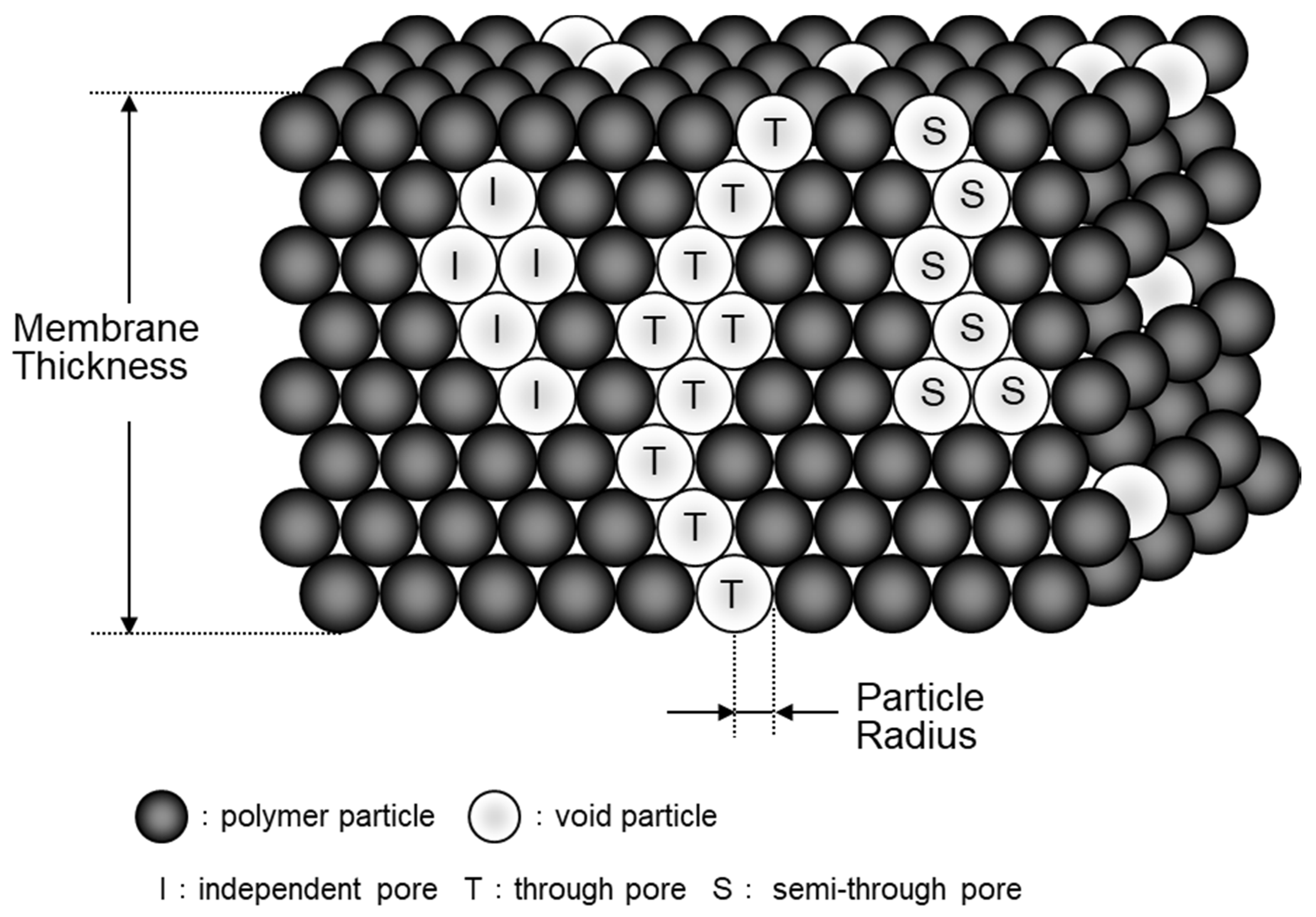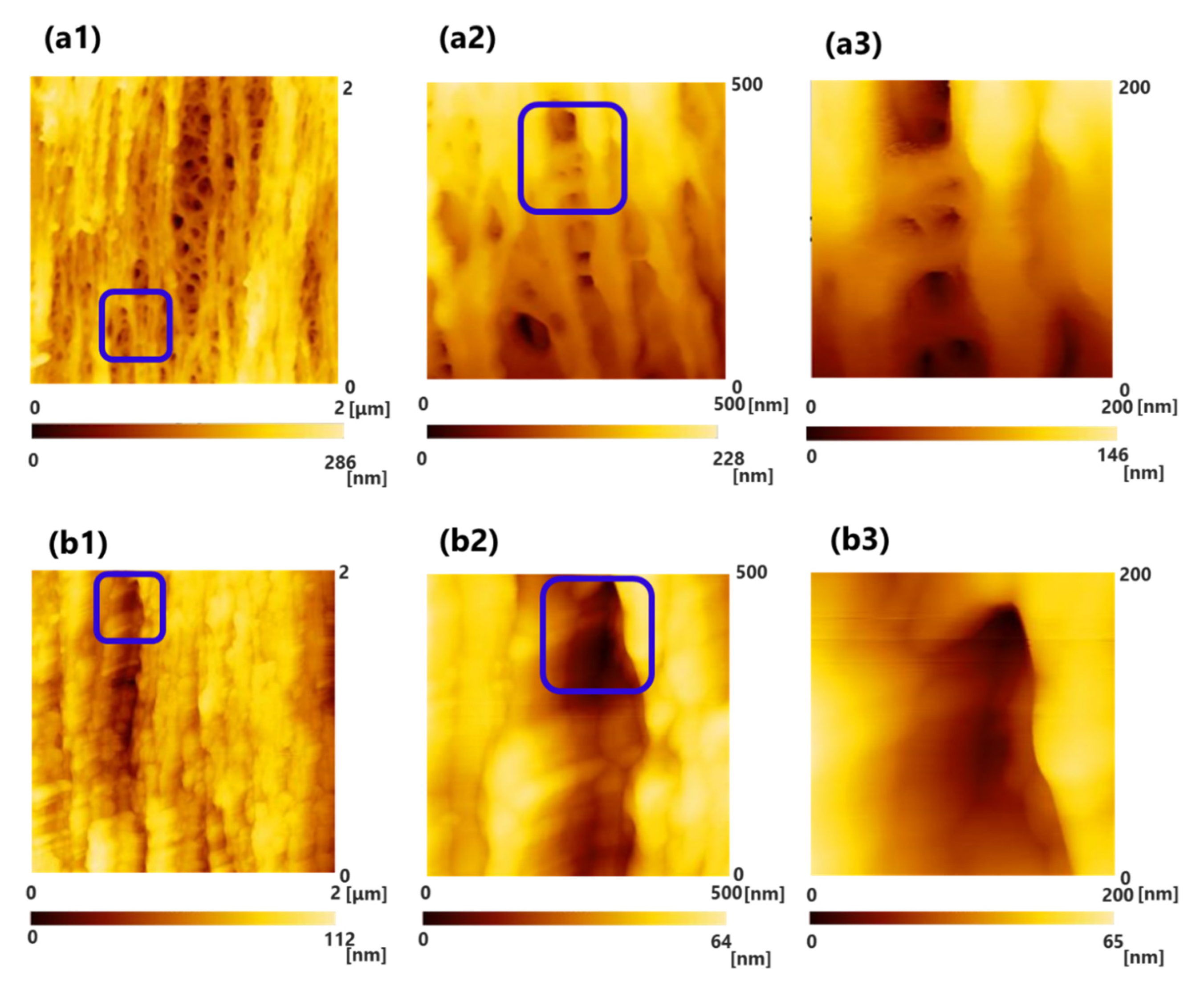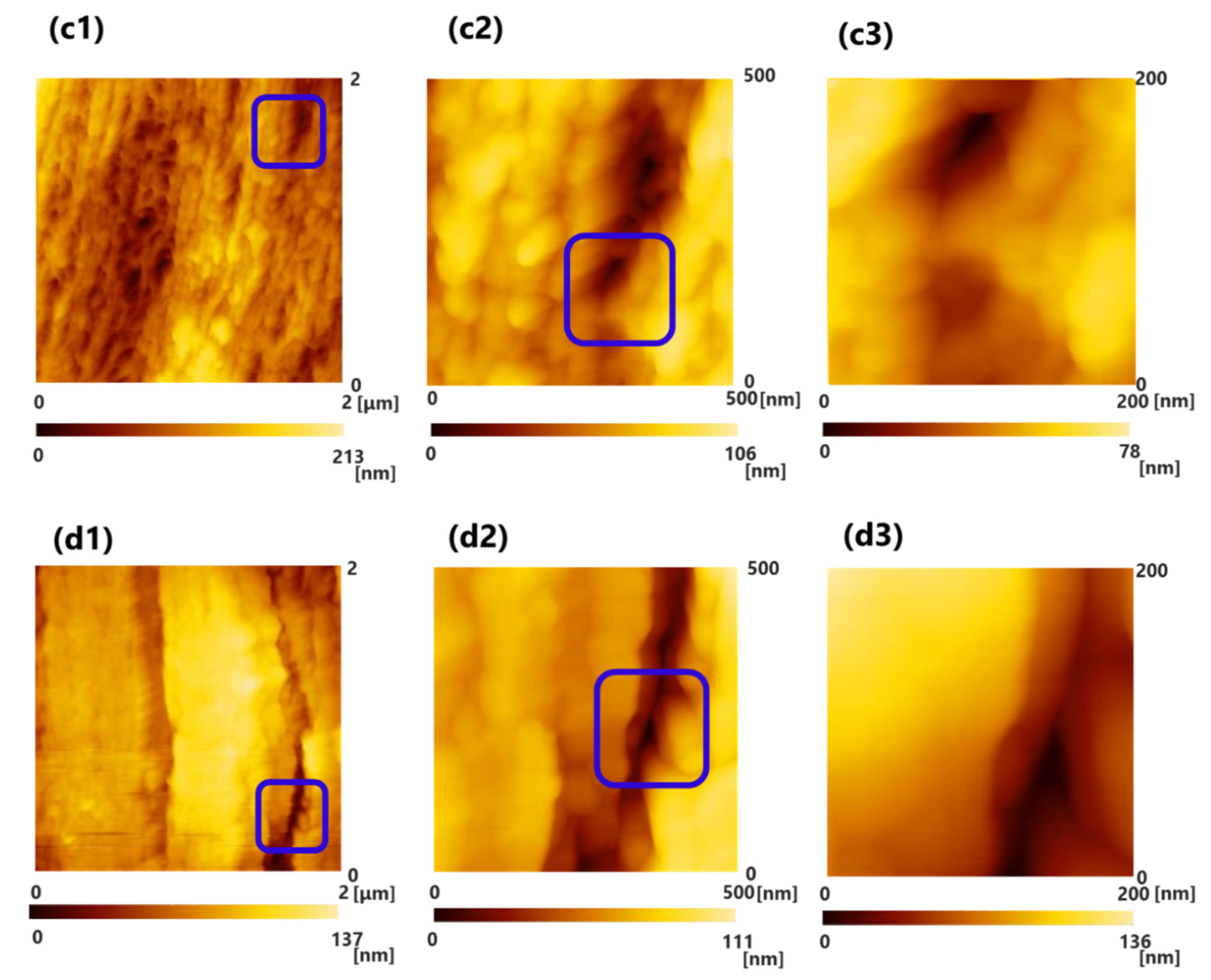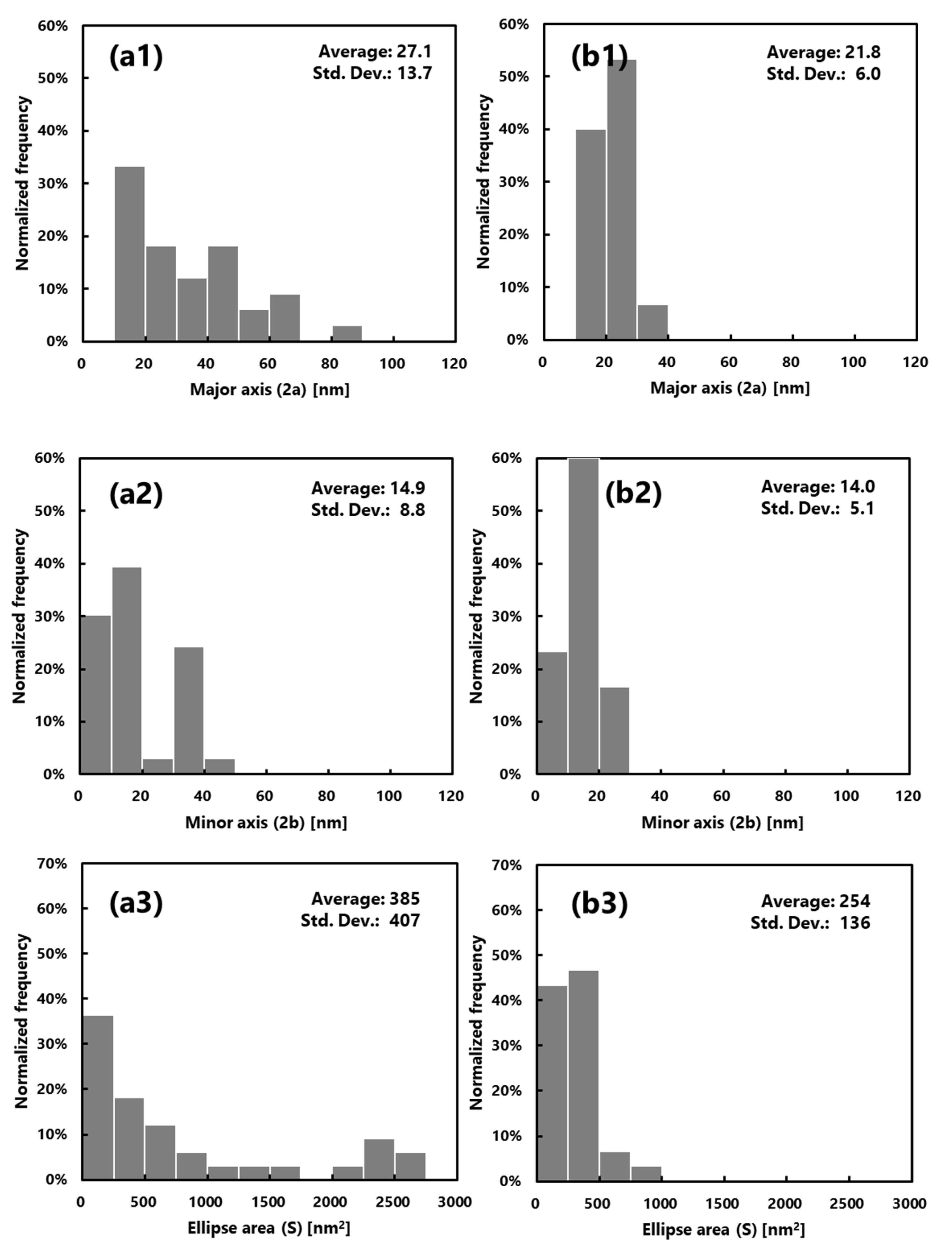Validity of Three-Dimensional Tortuous Pore Structure and Fouling of Hemoconcentration Capillary Membrane Using the Tortuous Pore Diffusion Model and Scanning Probe Microscopy
Abstract
:1. Introduction
2. Materials and Methods
2.1. Hemoconcentration Membrane (Hemoconcentrator)
2.2. Bovine Blood Perfusion Experiment, Measurement of Sieving Coefficient (SC)
2.3. Observation of Three-Dimensional Tortuous Pore Using a SPM System
2.4. Observation of Three-Dimensional Tortuous Pores Using Field Emission Scanning Electron Microscope (FE-SEM)
3. Results
3.1. Observation of Three-Dimensional Tortuous Pores of Inner Lumen Surface of the Capillary Membranes
3.2. Determination of Three-Dimensional Tortuous Pore Diameter and Distribution Using a Line Analysis
3.3. FE-SEM Observations of the Inner Surfaces of the Membrane
4. Discussion
4.1. Change in Pore Structure and Mass Transfer Property Due to Protein Fouling
4.2. Tortuous Pore Diffusion Model (TPD Model)
4.3. Comparison of Pore Diameters Calculated by the Tortuous Pore Diffusion Model (TPD Model) and Measured by SPM
5. Conclusions
Author Contributions
Funding
Acknowledgments
Conflicts of Interest
Abbreviations (List of Nomenclature)
| A surface area | (m2) |
| AK surface porosity | (-) |
| c concentration | (mg/mL) |
| DO diffusion coefficient of the solute in water | (m2/s) |
| f(q) friction coefficient of the of the pore walls and water with the solute in diffusion | (-) |
| H water content | (v/v%) |
| Lp pure water permeability | (mL/m2h mmHg) |
| QB flow rate of blood side | (mL/min) |
| QF filtration flow rate | (mL/min) |
| SC sieving coefficient | (-) |
| TMP transmembrane pressure | (mmHg) |
References
- Takeuchi, M.; Morita, K.; Iwasaki, T.; Toda, Y.; Oue, K.; Kawada, M.; Sano, S. Significance of Early Extubation after Pediatric Cardiac Surgery. Pediatr. Cardiol. Card. Surg. 2001, 17, 405–409. [Google Scholar]
- Lee, E.-H.; Chin, J.-H.; Choi, D.-K.; Hwang, B.-Y.; Choo, S.-J.; Song, J.-G.; Kim, T.-Y.; Choi, I.-C. Postoperative hypoalbuminemia is associated with outcome in patients undergoing off-pump coronary artery bypass graft surgery. J. Cardiothorac. Vasc. Anesth. 2011, 25, 462–468. [Google Scholar] [CrossRef]
- Fukuda, M.; Saomoto, H.; Mori, T.; Yoshimoto, H.; Kusumi, R.; Sakai, K. Impact of three-dimensional tortuous pore structure on polyethersulfone membrane morphology and mass transfer properties from a manufacturing perspective. J. Artif. Organs 2020, 23, 171–179. [Google Scholar] [CrossRef]
- Hiyoshi, T. Is there a limit to the spinning processes of dialysis membranes? (In Japanese). Jin to Touseki 1996, 96 (Suppl. 40), 26–30. [Google Scholar]
- Sakai, K.; Takesawa, S.; Mimura, R.; Ohashi, H. Determination of pore radius of hollow fiber dialysis membranes using tritium-labeled water. J. Chem. Eng. Jpn. 1988, 21, 207–210. [Google Scholar] [CrossRef] [Green Version]
- Sakai, K. Determination of pore size and pore size distribution: 2. Dialysis membranes. J. Membr. Sci. 1994, 96, 91–130. [Google Scholar] [CrossRef]
- Sakai, K.; Fukuda, M.; Namekawa, K. Advent and Evolution of Blood Purification Membranes and Expectations for the future (In Japanese). J. Jpn. Soc. Blood Purif. Crit. Care 2019, 10, 1–16. [Google Scholar]
- Fournier, R.L. Chapter 6 Mass Transfer in Heterogeneous Materials. In Basic Transport Phenomena in Biomedical Engineering, 4th ed.; Fournier, R.L., Ed.; CRC Press: Boca Raton, FL, USA, 2017; pp. 289–347. [Google Scholar]
- Krantz, W.B.; Greenberg, R.A.; Kujundzic, E.; Yeo, A.; Hosseini, S.S. Evapoporometry: A novel technique for determing the pore-size distribution of membranes. J. Membr. Sci. 2013, 438, 153–166. [Google Scholar] [CrossRef]
- Akhondi, E.; Wicaksana, F.; Krantz, W.B.; Fane, A.G. Evapoporometry determination of pore-size distribution and pore fouling of hollow fiber membranes. J. Membr. Sci. 2014, 470, 334–345. [Google Scholar] [CrossRef]
- Matsuda, M.; Sakai, K. Solute Removal Efficiency and Biocompatibility of the High Performance Membrane—From Engineering Points of View. In High-Performance Membrane Dialyzers; Saito, A., Kawanishi, H., Yamashita, A.C., Mineshima, M., Eds.; Karger: Basel, Switzerland, 2011; Volume l73, pp. 11–22. [Google Scholar]
- Fukuda, M.; Kokubo, K.; Sakai, K.; Onishi, G.; Takewaki, K.; Hiyoshi, T. Anisotropic differences in solute transfer rate through asymmetric membranes for blood purification accompanied by filtration. Biochem. Eng. J. 1998, 2, 127–136. [Google Scholar] [CrossRef]
- Barzinb, J.; Fenga, C.; Khulbea, K.C.; Matsuura, T.; Madaenic, S.S.; Mirzadeh, H. Characterization of polyethersulfone hemodialysis membrane by ultrafiltration and atomic force microscopy. J. Membr. Sci. 2004, 237, 77–85. [Google Scholar] [CrossRef]
- Kaleekkal, N.J.; Thanigaivelan, A.; Tarun, M.; Mohan, D. A functional PES membrane for hemodialysis-preparation, characterization and biocompatibility. Chin. J. Chem. Eng. 2015, 23, 1236–1244. [Google Scholar] [CrossRef]
- Hayama, M.; Kohori, F.; Sakai, K. AFM observation of small surface pores of hollow fiber dialysis membrane using highly sharpened probe. J. Membr. Sci. 2002, 197, 243–249. [Google Scholar] [CrossRef]
- Yamamoto, K.-I.; Hayama, M.; Matsuda, M.; Yakushiji, T.; Fukuda, M.; Miyasaka, T.; Sakai, K. Evaluation of asymmetrical structure dialysis membrane by tortuous capillary pore diffusion model. J. Membr. Sci. 2007, 287, 88–93. [Google Scholar] [CrossRef]
- Yamazaki, K.; Matsuda, M.; Yamamoto, K.; Yakushiji, T.; Sakai, K. Internal and surface structure characterization of cellulose triacetate hollow fiber dialysis membranes. J. Membr. Sci. 2011, 368, 34–40. [Google Scholar] [CrossRef]
- Fukuda, M.; Saomoto, H.; Shimizu, T.; Namekawa, K.; Sakai, K. Observation and proposed measurements of three-dimensional tortuous capillary pores with depth for hollow fiber hemoconcentrator membrane using dynamic force microscopy. Adv. Biomed. Eng. 2019, 8, 145–152. [Google Scholar] [CrossRef]
- Kanamori, T.; Sakai, K.; Fukuda, M. Structural analysis of hemodialysis membranes by evaluating distribution volume of water contained in the membranes. J. Colloid Interface Sci. 1995, 171, 361–365. [Google Scholar] [CrossRef]
- Japanese Industrial Standards Committee. Japanese Industrial Standard, Haemodialysers, Haemodiafilters, Haemofilters and Haemoconcentrators JIS T 3250: 2013 (JMED/JSA). Published by Japanese Standards Relation, TOKYO; 2013. Available online: https://www.jisc.go.jp/ (accessed on 29 October 2020).
- Namekawa, K.; Fukuda, M.; Matsuda, M.; Yagi, Y.; Yamamoto, K.-I.; Sakai, K. Nanotechnological characterization of human serum albumin adsorption on wet synthetic polymer dialysis membrane surfaces. ASAIO J. 2009, 55, 236–242. [Google Scholar] [CrossRef]
- Ji, H.; Xu, H.; Jin, L.; Song, X.; He, C.; Liu, X.; Xiong, L.; He, C.; Zhao, C. Surface engineering of low-fouling and hemocompatible polyethersulfone membranes via in-situ ring-opening reaction. J. Membr. Sci. 2019, 581, 373–382. [Google Scholar] [CrossRef]
- Koga, Y.; Fujieda, H.; Meguro, H.; Ueno, Y.; Aoki, T.; Miwa, K.; Kainoh, M. Biocompatibility of polysulfone hemodialysis membranes and Its mechanisms: Involvement of fibrinogen and Its integrin receptors in activation of platelets and neutrophils. Artif. Organs 2018, 42, 246–258. [Google Scholar] [CrossRef]
- Hedayat, A.; Szpunar, J.; Kumar, N.A.P.K.; Peace, R.; Elmoselhi, H.; Shoker, A. Morphological characterization of the Polyflux210H hemodialysis filter pores. Int. J. Nephrol. 2012, 2012. [Google Scholar] [CrossRef] [PubMed]
- Iwata, H. Advanced Polymer Materials One Point 3 Biomaterials; In Japanese; Kyoritsu Shuppa: Tokyo, Japan, 2005; pp. 5–45. [Google Scholar]
- Alqaheem, Y.; Alomair, A.A. Microscopy and Spectroscopy Techniques for Characterization of polymeric membranes. Membranes 2020, 10, 33. [Google Scholar] [CrossRef] [PubMed] [Green Version]
- Pappenheimer, J.R.; Renkin, E.M.; Borrero, L.M. Filtration, diffusion and molecular sieving through peripheral capillary membranes. Am. J. Physiol. 1951, 167, 13–46. [Google Scholar] [CrossRef]
- Kedem, O.; Katchalsky, A. Thermodynamic analysis of the permeability of biological membranes to non-electrolytes. Biochim. Biophys. Acta 1958, 27, 229–246. [Google Scholar] [CrossRef]
- Kedem, O.; Katchalsky, A. A physical interpretation of the phenomenological coefficients of membrane permeability. J. Gen. Physiol. 1961, 45, 143–179. [Google Scholar] [CrossRef] [Green Version]
- Verniory, A.; Du Bois, R.; Decoodt, P.; Gassee, J.P.; Lambert, P.P. Measurement of the permeability of biological membranes. Application to the glomerular wall. J. Gen. Physiol. 1973, 62, 489–507. [Google Scholar] [CrossRef] [Green Version]
- Klein, E.; Holland, F.; Lebeouf, A.; Donnaud, A.; Smith, J. Transport and mechanical properties of hemodialysis hollow fibers. J. Membr. Sci. 1976, 1, 371–396. [Google Scholar] [CrossRef]
- Klein, E.; Holland, F.; Eberle, K. Comparison of experimental and calculated permeability and rejection coefficients for hemodialysis membranes. J. Membr. Sci. 1979, 5, 173–188. [Google Scholar] [CrossRef]
- Liao, Z.; Klein, E.; Poh, C.K.; Huang, Z.; Lu, J.; Hardy, P.A.; Gao, D. Measurement of hollow fiber membrane transport properties in hemodialyzers. J. Membr. Sci. 2005, 256, 176–183. [Google Scholar] [CrossRef]







| Membrane Tested | Manufacturer | Pure Water Permeability [mL/hr/mmHg/m2] | Inner Diameter [μm] | Wall Thickness [μm] | Sterilization Condition | Sterilization Method |
|---|---|---|---|---|---|---|
| PUREMA A | 3M Co., Ltd. (Aqua Stream®, JMS Co., Ltd. Japan) | 207 ± 5 | 200 | 30 | Dry | Ethylene Oxide Gas (EOG) |
| PUREMA B | 3M Co., Ltd. (Aqua Stream®, JMS Co., Ltd. Japan) | 115 ± 2 | 200 | 30 | Dry | Ethylene Oxide Gas (EOG) |
| Equipment | JSM-7610F (Jeol Ltd., Japan) |
|---|---|
| Observation mode | Secondary electron image |
| Accelerating voltage | 1.5 kV |
| Emission current | 47.2 µA |
| Working distance | 4.5 mm |
| Magnifications | 100,000 |
| Sample | Pure Water Permeability Lp (mL/hr/mmHg/m2) (1) | Sieving Coefficient of Albumin (-) (2) | ||
|---|---|---|---|---|
| Before Blood Contact | After Blood Contact (High Load) | After Blood Contact (Low Load) | ||
| PUREMA A | 207 ± 5 | 180 ± 4 * | 194 ± 3 * | 0.01 ± 0.02 |
| PUREMA B | 115 ± 2 | 114 ± 1 * | 116 ± 1 | 0.02 ± 0.01 |
| Sample | Pore Diameter Calculated from the Tortuous Pore Diffusion Model (nm) | Pore Diameter as Observed with SPM (Before Blood Contact) (1) | ||||
|---|---|---|---|---|---|---|
| Before Blood Contact | After Blood Contact (High Load) | After Blood Contact (Low Load) | Long Axis (nm) | Short Axis (nm) | Mean (nm) | |
| PUREMA A | 30.5 | 28.5 | 29.5 | 27.1 ± 13.7 * | 14.9 ±8.8 * | 24.6 |
| PUREMA B | 23.1 | 22.9 | 23.1 | 21.8 ± 6.0 | 14.0 ± 5.1 | 17.9 |
Publisher’s Note: MDPI stays neutral with regard to jurisdictional claims in published maps and institutional affiliations. |
© 2020 by the authors. Licensee MDPI, Basel, Switzerland. This article is an open access article distributed under the terms and conditions of the Creative Commons Attribution (CC BY) license (http://creativecommons.org/licenses/by/4.0/).
Share and Cite
Fukuda, M.; Yoshimoto, H.; Saomoto, H.; Sakai, K. Validity of Three-Dimensional Tortuous Pore Structure and Fouling of Hemoconcentration Capillary Membrane Using the Tortuous Pore Diffusion Model and Scanning Probe Microscopy. Membranes 2020, 10, 315. https://doi.org/10.3390/membranes10110315
Fukuda M, Yoshimoto H, Saomoto H, Sakai K. Validity of Three-Dimensional Tortuous Pore Structure and Fouling of Hemoconcentration Capillary Membrane Using the Tortuous Pore Diffusion Model and Scanning Probe Microscopy. Membranes. 2020; 10(11):315. https://doi.org/10.3390/membranes10110315
Chicago/Turabian StyleFukuda, Makoto, Hiroki Yoshimoto, Hitoshi Saomoto, and Kiyotaka Sakai. 2020. "Validity of Three-Dimensional Tortuous Pore Structure and Fouling of Hemoconcentration Capillary Membrane Using the Tortuous Pore Diffusion Model and Scanning Probe Microscopy" Membranes 10, no. 11: 315. https://doi.org/10.3390/membranes10110315





